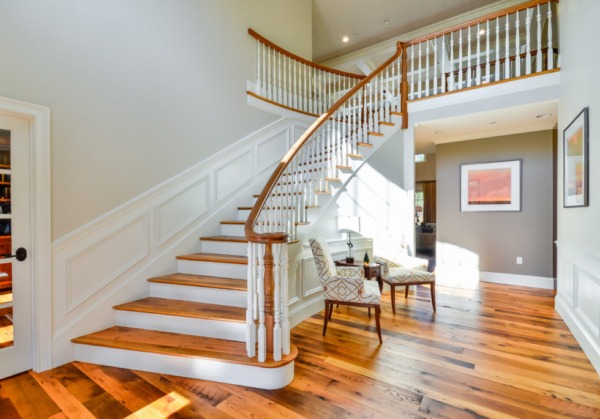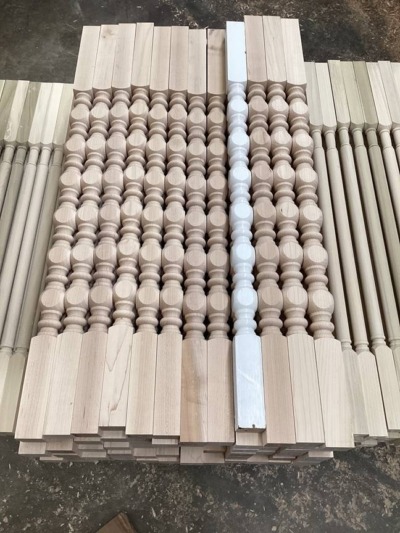Note: This guide is primarily for replacing existing stair spindles. If you’re installing spindles on a brand-new staircase or building a railing from scratch, use our full installation guide instead.
Many homeowners will never give their stair spindles (also known as balusters) a second thought, but they should. These stair parts play a huge role in your home’s safety and style. The good news is that if they’re in need of updating, it’s a DIY-friendly project you can tackle without needing to hire a contractor.
Our guide will walk you through how to swap out old spindles without rebuilding your railing. If your spindles are loose or cracked, this upgrade can completely change the look of your staircase with minimal tools and a bit of patience.

Entryway with Updated Wood Stair Spindles
Updating your spindles can completely refresh a staircase without rebuilding the railing.
When Should You Replace Stair Spindles?
It’s not always obvious when it’s time to replace the spindles on your stairs. Here are a few scenarios where it makes sense to consider doing so:
Planning Tip: Not sure how many spindles you’ll need for your project? Try our free Baluster Spacing Calculator to find out. Just enter your measurements and some other basic information, and it will help you determine the right quantity based on your railing length and desired spacing.
Step-by-Step Guide to Replacing Stair Spindles
- 1Remove the Old Spindles: Start at one end of your railing and work your way along to see which need replacing. Most spindles are glued or nailed into small holes in the tread and handrail. Use a pry bar or flathead screwdriver to gently remove each spindle that needs to be replaced. Be patient here and avoid damaging the tread or handrail. If a spindle is stubborn and won’t come loose, cutting it in half with a hand saw may make removal easier. Clean away any leftover glue or nails before moving on to the next step.
- 2Prepare the Staircase: After removing the old spindles, inspect the existing holes. In most cases, you’ll be reusing them as-is. If a hole is damaged or too loose for a snug fit, fill it with wood filler or a wood plug and redrill in the same spot once dry.
- 3Measure for New Spindle Placement: If you’re replacing one-for-one, align new spindles using the existing hole positions. Only remeasure spacing if your old layout was inconsistent or out of code. Remember that in most cases and locations, there should be no more than 4 inches between spindles. This is critical for both safety and code compliance.
- 4Test Fit the New Spindles: Before gluing anything into place, do a dry run. Insert the top end into the handrail groove, then lower the bottom into the tread hole. Make sure the spindle stands straight and fits snugly. Use a level if needed. If something feels off, adjust hole depth or trim the spindle slightly.
- 5Install the New Spindles: Apply wood glue to the top and bottom of each spindle. Insert the top into the handrail groove and press the bottom into the tread hole. Hold for a few seconds to let the glue set. For most replacement projects, glue alone will secure the spindle. If a spindle doesn’t sit snugly, painter’s tape can temporarily hold it while drying. Repeat this process for each spindle, wiping away any glue drips as you go. Once everything is in, let the glue cure for at least 24 hours.
Need help figuring out how many spindles you need or how far apart to place them? Use our Baluster Spacing Calculator. It does the math for you!
Tips for a Professional-Looking Finish

Example of Close-Up of Painted Wood Spindles After Replacement
Pre-finishing your spindles makes installation cleaner and helps achieve a consistent look.
Final Checks Before You’re Done
Installing Balusters on a New Railing Instead of Replacing?
If you’re starting from scratch or installing new balusters on a fresh railing rather than reusing existing holes, you may want to check out our DIY Guide to Installing Wood Stair Balusters for help from the ground up.
Conclusion: A Small Upgrade With Big Impact
Fresh wood spindles make your home feel more finished and show care for the details that matter. This is a project most homeowners can handle on their own with just a little time and guidance.
Whether you’re swapping five wobbly spindles or updating every spindle in your staircase, Arnold Wood Turning is here to help. We’ve been crafting high-quality custom wood products for over 100 years. From simple replacements to complete stair overhauls, we’ve got the spindles and expertise you need.
Ready to Start Your Stair Makeover?
Get custom wood stair spindles made just for your project and request a free quote from our team for personalized service. Over 100 years of wood turning experience, trusted by builders and homeowners alike!
Frequently Asked Questions (FAQs) for Changing Spindles
- All
- Changing Wood Spindles – Measuring & Fitment
- Changing Wood Spindles – Partial vs. Full Replacement
- Changing Wood Spindles – Style & Finish Decisions
- Changing Wood Spindles – Tools & DIY Process
Yes. Many replacements will only require a pry bar, hand saw, and wood glue. If your spindles are pre-sized, it’s a lift, insert, and glue job that can be done without carpentry experience.
Score along the edges with a utility knife, then cut the spindle in half with a handsaw and pry each piece out separately. This avoids damaging your tread or railing when dealing with stubborn glue joints.
Absolutely. As long as the top and bottom rails are solid, you can replace straight or metal balusters with decorative turned wood styles. You may want to choose a spindle with a similar mounting method or dowel size for faster installation.
Yes, as long as the style matches. If your design is discontinued, a supplier can replicate your existing spindle profile so replacements blend in seamlessly without redoing the entire railing.
If they’re too loose, you can use a small wood shim or apply wood glue with sawdust for a snug fit. If they’re too tight, lightly sand the dowel end or trim the bottom with a handsaw. Ordering custom-turned spindles to your exact dowel size eliminates this issue entirely.
Remove one spindle and measure its total length, top and bottom dowel diameters (if present), and the distance between rails where it actually sits. If you’re unsure, send a photo with a tape measure next to it. A woodturning supplier can likely size-match it for you before production.

